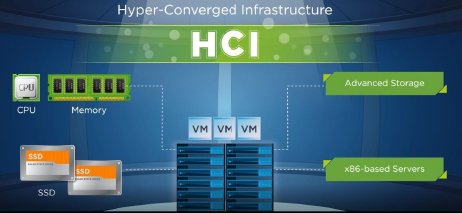Hyperconvergence 2.0, The Next Generation Of Provisioning Infrastructure For Cloud Hybrid Services
Hyperconvergence, like convergence, integrates data center services such as servers, storage, and networking to overcome common management problems of information technology infrastructures and provides an integrated mechanism based on a centralized management interface. Simplifies infrastructure.
However, unlike convergent methodology, provisioning is a software-centric infrastructure in which infrastructure management operations are separated from hardware.
The Hyperconverged Infrastructure (HCI) has been around for more than a decade to simplify data center operations and enable faster and cheaper scalability than older three-tier models.
However, HCI was not at a standstill and made significant progress. HCI is a software-centric infrastructure with fully integrated networking, computing, and storage services installed on an x86 server.
Next, this HCI server can be managed as a cluster.
An HCI infrastructure includes software-driven storage, a hypervisor for virtualized computing, an operating system, and a virtual network, all managed through a single system management console.
An organization can build its own HCI clusters by purchasing an HCI software infrastructure and implementing it on any x86 server. HCI is suitable for small or new applications that are programmed for scalability thanks to its great flexibility.
Common uses for HCI include event backup and recovery, offices or remote branches, shared storage clusters, virtual desktop implementations, private cloud implementations, and software-centric data centers.
One of the biggest challenges for people who manage infrastructure is delivering predictable performance, especially in the face of application services and workloads.
Dedicated infrastructure to meet future needs is not an economical option.
When multiple applications share a common infrastructure, one application can interfere with the performance of other applications.
Provider infrastructure offers a unique solution for service quality, including centralized control of all applications, elimination of additional processing, and compliance with all performance service level agreements (SLAs).
As a result, the user can implement all the required applications predictably and reliably on a shared platform.
A new generation of provisioning infrastructures has emerged as the foundation for the implementation of hybrid cloud IT operations that utilize privately owned and locally-based cloud technologies.
Network experts believe that this software-based approach has evolved to meet many needs, including the development of internal applications and the ability to transfer data and applications between cloud environments, cloud data centers, and centralized.
“The value proposition of convergent infrastructure solutions to meet the needs of the hyper-hybrid world has evolved,”
says Eric Shepard, Vice President of Infrastructure Technology Research at IDC.
“Modern convergent solutions make progress because they enable organizations to take advantage of standardized, software-centric, fully automated data center infrastructures that form the backbone of an integrated, multi-location world.”
Provider infrastructure uses intelligent software to virtualize, integrate, and control data center technologies more easily. IT departments Organizations use HCIs to reduce the total cost of ownership (TCO), increase the performance and scalability of IT services, and improve overall productivity.
“HCI 2.0 stands for Hybrid Cloud Infrastructure, which shows that this old infrastructure has changed in line with developments in the world of technology,”
said Maness Bacharia, Nutanix Senior Vice President of Engineering.
He believes the new generation of provocative infrastructure balances the capabilities of the private and public cloud. HCI has become the foundation of hybrid cloud infrastructure.
“Part of this infrastructure has the ability to run enterprise applications in a public cloud and to easily manage and run locally deployed applications,” he says.
Private cloud engine
HCI is essentially a software-based IT infrastructure that integrates and virtualizes data center computing, storage space, and network devices. Like the cloud, HCI can be expanded quickly and can be expanded by adding one server node at a time.
The software virtualizes systems to provide a solid foundation for running powerful private clouds within enterprise data centers.
With the creation of a hybrid cloud that ultimately has manageability, security, and shared use, there will be virtually no boundary between on-site or off-cloud computing environments.
A three-year study called the Enterprise Cloud Index (ECI) commissioned by Nutanix shows that between 85% and 91% of global IT architects consider the hybrid cloud to be their ideal IT operating model.
The question is, where is HCI’s place in this emerging and integrated environment?
“HCI implemented in private infrastructure is known as HCI 1.0, and HCI implemented in the public cloud is known as HCI 2.0,” says Baccharis. Studies show that the hybrid cloud and HCI will move in the same direction.
ECI 2020 data also confirms this, showing that organizations that have embraced hybrid cloud are more inclined to HCI than businesses that implement other IT operations models.

Introduction of public cloud platforms
One of the main reasons for the rapid change in convergent and provocative infrastructures is the recent move by large public cloud service providers to support non-hardware computing that allows on-site cloud software and workloads to run in native environments.
For Baccharis, this is a strategic shift in HCI that could now spread to the public cloud.
“Without hardware control, we could not control the performance of the application,” he says.
“Until recently, we were able to use whatever the public cloud vendors had to offer, and we were limited to their services.”
Now the situation has changed. One of these developments is Nutanix clusters on AWS. This software service extends the Nutanix private cloud and its services to examples (Amazon EC2) of the Amazon Elastic Compute Cloud header in the Amazon Web Services header (AWS).
This type of configuration enables organizations to easily build a hybrid cloud infrastructure with the ability to move resources in cloud locations without the need to rebuild applications.
“A version of Nutanix clusters is also being developed for Microsoft Azure,” says Baccharis.
Workload strategies
Although the public cloud is becoming the destination of choice for many enterprise applications and services, some workloads may never leave the data center for a variety of reasons, including security, monitoring, and access speed concerns.
For example, delayed transaction processing applications may remain in local infrastructure for functional reasons, but organizations may be willing to transfer data to the cloud for analysis and storage.
“This means that IT executives need a single view of all their infrastructure and the option to move workloads quickly wherever it makes sense,” said Steve McDowell, senior analyst at Moor Insights & Strategy. »
Using a single HCI platform in both environments allows for such flexibility. “You have to be able to get an app built on any cloud and run it on another cloud with the same features,” says Baccharis.
HCI: Operating System for Hybrid Cloud
If customers can build a similar version of their on-site infrastructure on the cloud, then they can move workloads to any location that makes sense to run. “Your traditional transaction database can be deployed on-site while the workload can be on the cloud,” says Baccharis.
“You can transfer data to the cloud via FTP, and from there you can do the analysis.”
“Cloud infrastructure has other inherent benefits, including data backup and recovery applications and sustainable security, disaster recovery, capacity management, and overall sovereignty,” said Lucas Marian, IDC Research Director.
The virtual machine hypervisor has become a data center operating system but has no consequences for the hybrid cloud.
A single provider infrastructure in both locations will no longer require network management and storage and will become the next operating system for your data center.
In addition, the HCI developed with a fee-based payment mechanism will save on overall costs.
Claimants of public and private services
Organizations other than HCI vendors strive to provide their customers with cloud-based infrastructure. For example, Microsoft and Amazon, which provide public cloud infrastructure, are trying to allow their customers to take advantage of new provider infrastructure through solutions such as Amazon’s Outposts and Microsoft’s Azure Stack. McDowell believes that the service providers are trying to simplify the process of transferring customer workloads to the provisioning infrastructure.
“The main gift of HCI is the simplicity, flexibility, and scalability of infrastructure compared to traditional methods,” he says.
This superiority is supported by the fact that in HCI all components of the system are integrated into one entity and managed by common software.
HCI helps you fill in the gaps. By providing a centralized control management center, HCI allows you to easily manage multiple different cloud services. Another evolving path for HCI 2.0 is to reach the edge of the network.
“With the advent of high-speed 5G wireless services, edge computing will be closer to where data is stored.”
The HCI paradigm is very popular right now, and many products have been marketed with this approach. We reviewed some of these products in this article.
However, an expert analysis should be performed to determine whether the above products comply with the HCI promises. In the HCI paradigm, the desired hardware can be easily purchased and added to the suite.
The central management software automatically integrates the new hardware components with the previous ones and performs the necessary configuration.
One of them is the network configuration, in which the software, by changing it, prepares the network for new conditions to maintain coordination and compatibility between the various components of the system.

